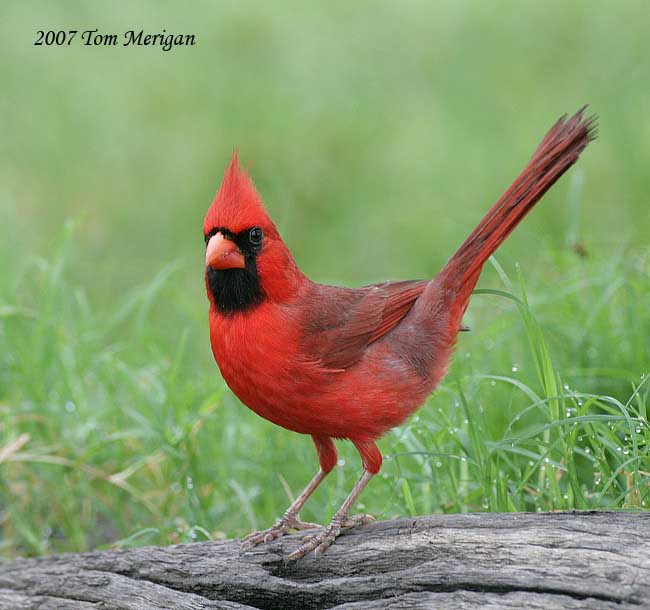
Northern Cardinal
Cardinalis cardinalis
Passeriforme Order – Cardinalidae family
BIOMETRICS:
Length: 21-23 cm
Wingspan: 25-31 cm
Weight: 42-48 g
LONGEVITY: up to 15 years
DESCRIPTION:
Northern Cardinal adult male has red plumage, and black mask on face, forehead, eyes, chin and throat.
Female is buff brown or olive, tinged with red on wings, crest and tail. She has not black mask, but the same parts of her face may be dark.
Male and female have cone-shaped reddish bill. Tail is long. A distinctive crest of feathers on the top of their head gives them some elegance. Male is larger than female. Legs and feet are dark red.
Juvenile resembles female, but it has grey black bill. Juvenile female lacks red tones.
Similar species: Pyrrhuloxia. Females are very similar.

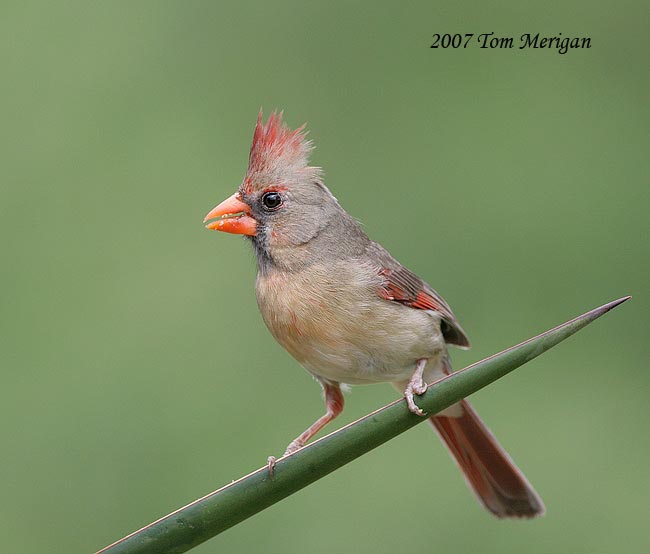
VOICE: SOUNDS BY XENO-CANTO
Northern Cardinal’s song is a loud, liquid whistling with many variations “cheer-cheer-cheer” and “purty-purty-purty”. Common call is a short “chip”. It is a contact and alarm call. Both adults sing together, female duetting with male during breeding season, but both sexes sing almost the entire year.
HABITAT:
Northern Cardinal lives in woodland edges, swamps, streamside thickets, and vegetation around houses in suburban areas.
RANGE:
Northern Cardinal is abundant throughout eastern and central North America, southwards from Florida and Mexico to Belize and Guatemala. Local populations in Arizona, California and New Mexico. Introduced to Hawaii and Bermuda.
BEHAVIOUR:
Northern Cardinal feeds in large flocks in winter, up to 60 to 70 birds.
This bird is very popular, always present at bird feeders in winter, at dawn and dusk. It feeds mainly on the ground in open thickets, but it forages in trees and bushes.
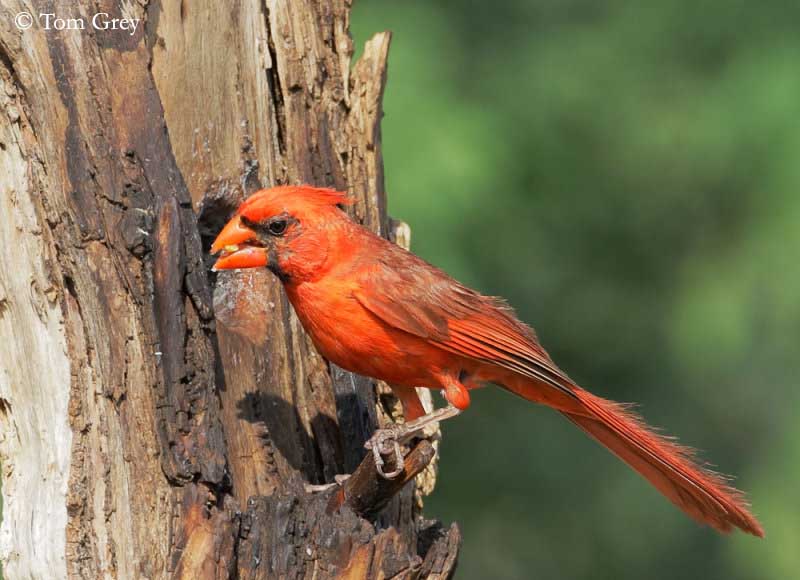
Male Northern Cardinal is very territorial and defends its territory from others males. But if it sees its reflexion in a glass, it may fight during hours against this intruder!
Males with brighter red colours have territories with denser vegetation; they feed at higher levels and have greater success with females than other males.
Northern Cardinals are monogamous. During breeding season, male and female perform courtship displays with outstretched necks, erect crest and swaying their bodies from side to side, singing softly at the same time.
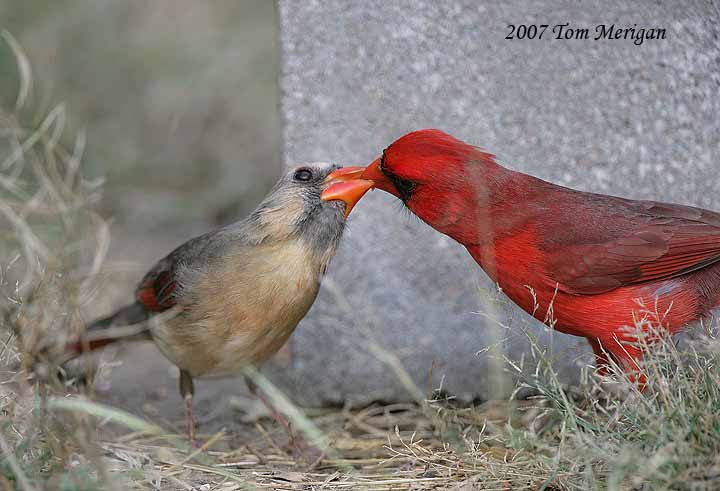
Both adults remain together throughout the entire year. Mates may offer each other a seed, touching their beaks briefly. This behaviour may happen up to four times per minute when birds meet, and during breeding and nesting season.
Northern Cardinal is not migratory; they are resident year round in their range. It is active during the day. They gather and roost in groups in winter.
Northern Cardinal uses sounds and physical displays to communicate. Their beautiful songs are used to defend the territory and during courtship. They also use visual displays when threatened, including “tail-flick” and raising and lowering their crests. When an intruder approaches near the nest, both parents give an alarm call “chip” and fly towards predator, attempting to scare it away.
FLIGHT:
Northern Cardinal’s flight is strong and rapid, but on short distances. It performs gliding and jerks of the tail.
REPRODUCTION:
Northern Cardinal nests in dense tangles of vines or twigs, in shrubs and small trees.
Female builds the nest. It is an open cup, made with twigs and grasses, weed stems, bark strips, rootlets, leaves and paper interwoven, and lined with fine grass and hair.
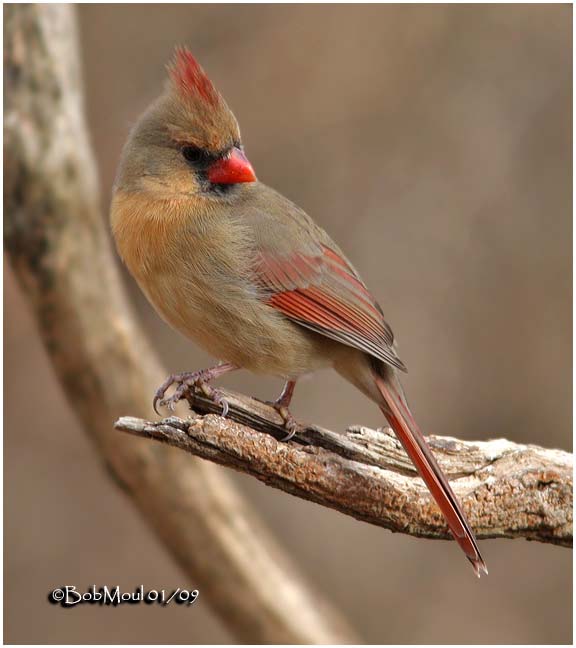
Female lays 1 to 5 white to greenish or bluish eggs, with brown spots. Incubation lasts about 11 to 13 days, by female alone, but she is fed by the male. She broods the altricial chicks the first two days, and they are fed by both parents. Their diet consists in insects.
Chicks begin to fledge at about 7 to 13 days after hatching, and they are fed for about one month after they leave the nest. After this period, young join flocks of juveniles. They reach their sexual maturity at one year.
This species produces two broods per season, sometimes more. Second clutch is often parasited by Brown-headed Cowbird. Male tends the first brood, while female prepares the second nest.
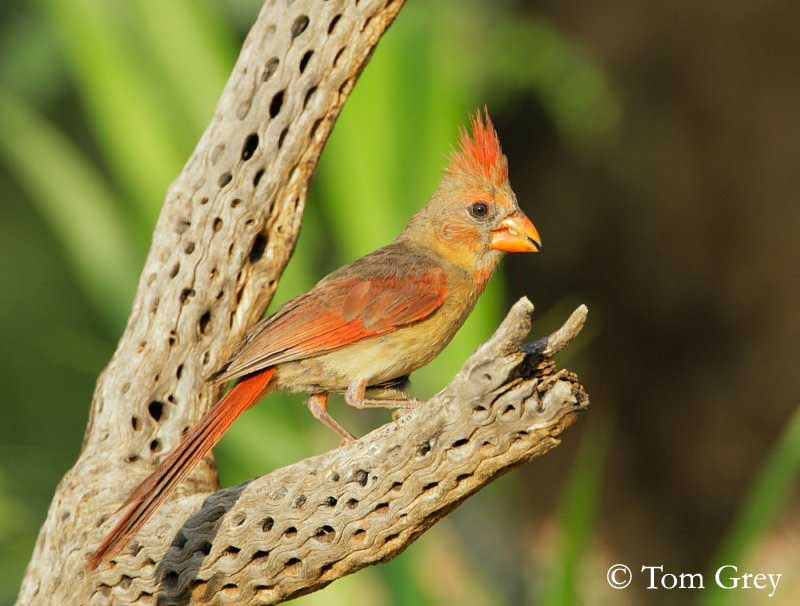
DIET:
Northern Cardinal feeds on seeds of corn and grasses, fruit (grapes and berries), sunflower seeds, buds and insects. Sometimes, they drink maple sap from sapsucker holes.
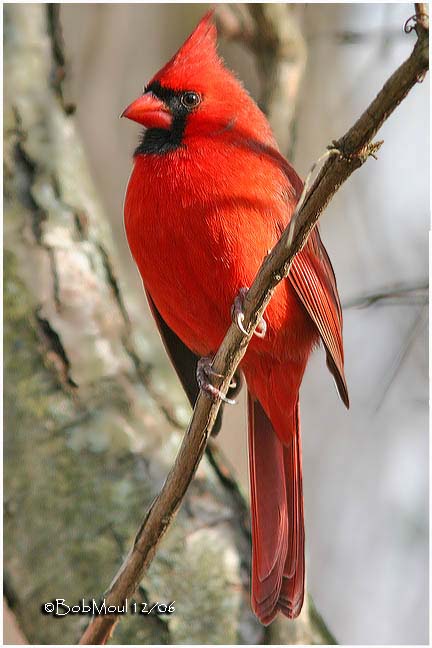
PROTECTION / THREATS / STATUS:
Northern Cardinal’s populations have increased, as a response to human changes in their habitat. Northern Cardinal benefits from bird feeders, and parks and suburban gardens. It may disappear in California, due to habitat loss.
Predators of this species are owls, hawks, Raccoons and Red Foxes.
Northern Cardinal is the state bird of seven states: Illinois, Indiana, Kentucky, North Carolina, Ohio, Virginia and West Virginia.
Fr: Cardinal rouge
All : Rotkardinal
Esp : Cardenal Norteño
Ital : Cardinale rosso
Nd : Rode Kardinaal
Sd : Röd kardinal
Photographs by Tom Merigan
His website : Tom Merigan’s Photo Galleries
Photographs by Tom Grey
His website: Tom Grey's Bird Pictures
Photographs by Bob Moul
His website: Nature Photography
Text by Nicole Bouglouan
Sources :
FIELD GUIDE TO THE BIRDS OF NORTH AMERICA - National Geographic Society - ISBN: 0792274512
L’ENCYCLOPEDIE MONDIALE DES OISEAUX - Dr Christopher M. Perrins - BORDAS - ISBN: 2040185607
All About Birds (Cornell Lab of Ornithology)
Wikipedia (Wikipedia, The Free Encyclopedia)
What Bird-The ultimate Bird Guide (Mitchell Waite)
Animal Diversity Web (University of Michigan Museum of Zoology)